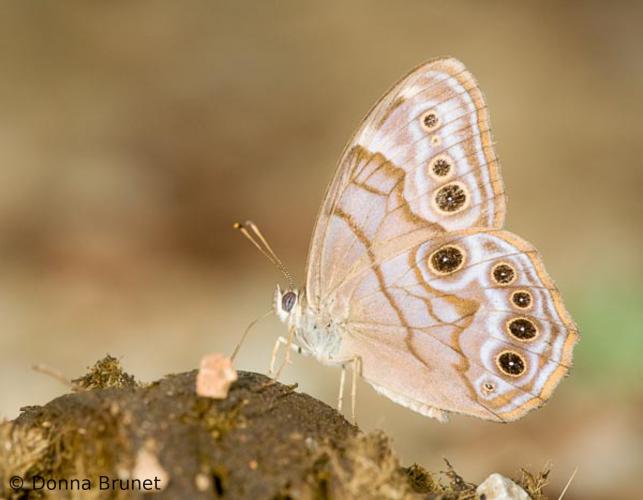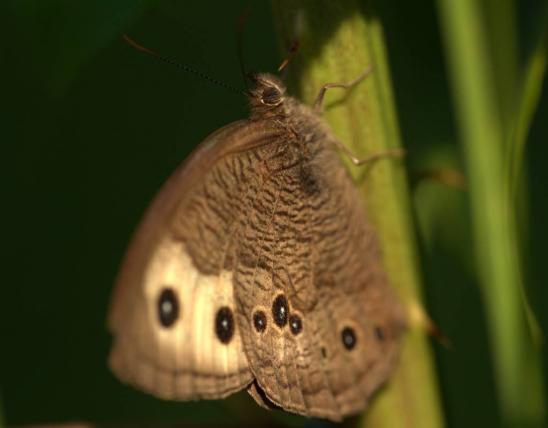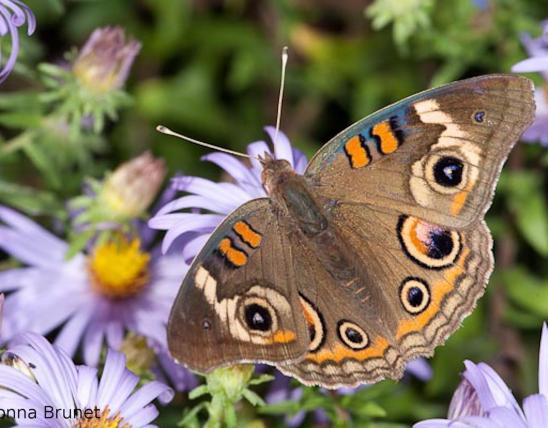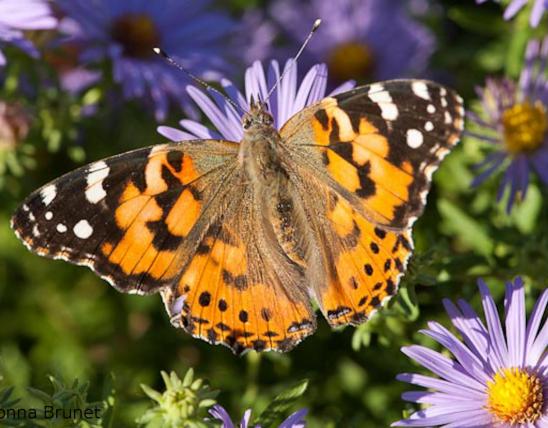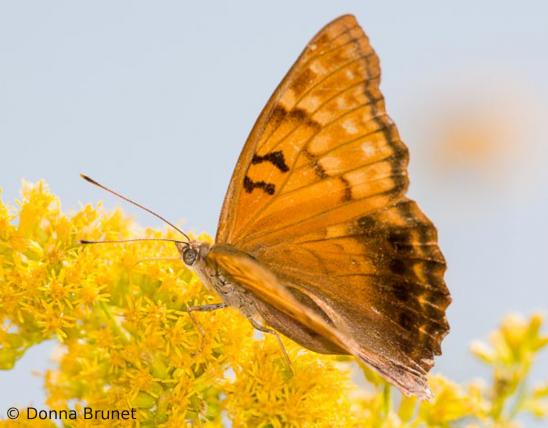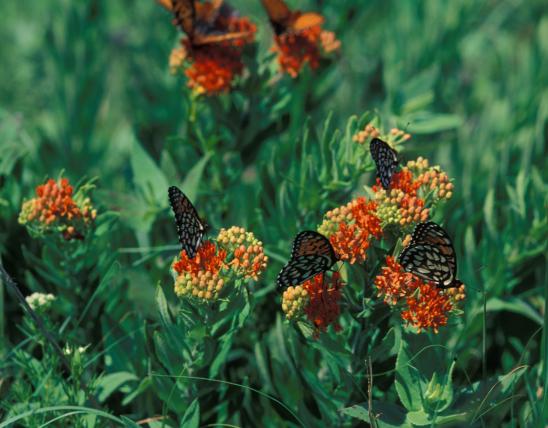
The northern pearly-eye is grayish brown with dark eyespots. The antennal clubs are black at the base with orange tips. On the underside, the 4 forewing eyespots are lined up in a straight line, with an undulating dark line below it, closer to the body.
Larvae taper at both ends and have tiny white tubercles and fine hairs. They are yellowish green with several green and yellow lengthwise stripes. The pair of backward-pointing horns at the rear end of the body, and the pair of forward-pointing horns on the head, are reddish-tinged.
Similar species: This is the only pearly-eye in most of Missouri. Our other two species are both restricted to moist woodlands with canebrakes in the southern part of the state:
- The southern pearly-eye (E. portlandia) has orange antennal clubs, is usually lighter brown, and has the underside forewing spots in a curving line; the dark line under them is straight or zigzag.
- The Creole pearly-eye (E. creola) has the underside forewing with 5 spots, and the brown line under them arches outward beyond the disc (the largish cell at the basal core of the wing) toward the wing tip. Male Creole pearly-eyes have pointed forewings, and on their forewing upper sides, darker scales contrast against the lighter-colored veins.
Missouri has other, less closely related species in this subfamily, such as satyrs, browns, wood-nymphs, and graylings. Fairly straightforward photo comparisons should make the differences between these and the three pearly-eyes clear.
Wingspan: 1½–2½ inches.
Ranges widely in Missouri.
Habitat and Conservation
This species is found in shady woodlands with understory grasses, often near creeks. The adults, especially males, spend much of their time sitting on tree trunks, usually in a head-down position, near woodland clearings. Pearly-eyes like shady places and woodlands; they are most often seen out in the open at dusk and dawn. To escape predators, they often disappear into grasses.
Food
Caterpillar host plants of this species comprise a variety of grasses, including long-awned wood grass (Brachyelytrum erectum), white grass (Leersia virginica), bottlebrush grass (Elymus hystrix), and river oats (Chasmanthium latifolium). These are all grasses of deciduous woodlands. Caterpillars feed mainly at night.
Adult pearly-eyes have relatively short proboscises (tubelike mouthparts) — as a result, they do not feed on flower nectar. Instead, they get moisture and nutrients from mud, dung, tree sap, decaying fruit, and carrion.
Status
Breeding resident found across Missouri in local colonies.
Life Cycle
There are two distinct broods in Missouri, with adults flying from late May through June and the end of July into September. Males perch on tree trunks and wait for females to approach. Females lay eggs singly on grasses, the larval host plants. This species hibernates as a partially grown larva, in the third or fourth stages.
Human Connections
The genus name, Enodia, references the goddess Ennodia, who was popular in Thessaly, Greece, in the 5th century. Apparently she was associated with roadsides, earthquakes, politics, the protection of youth, and especially, the underworld and the dead. Maybe these butterflies’ preference for shady, wooded areas inspired the genus name.
The alternate genus name, Lethe, is also from Greek mythology, where it was one of the five rivers in Hades (the underworld of the dead). The word literally meant “oblivion” or “forgetfulness.” Maybe this is another nod to these butterflies’ relatively dark habitats.
Even the species name, anthedon, seems to have come from Greek mythology. Entomologists in previous centuries tapped their classical educations, which included plenty of Greek mythology, to create rather poetic scientific names for the insects they formally described. Poets of the same era also freely used Greek mythology references.
Ecosystem Connections
Missouri’s woodlands teem with insect eaters, including a wide variety of birds, mammals, reptiles, amphibians, and other insects and spiders. The brown coloration and hopping flight of these butterflies help them survive long enough to create offspring.
Eyespots positioned at the outer margins of wings can fool predators into aiming at wingtips instead of the heads and bodily cores of butterflies. A pearly-eye can still fly around with jagged wings, missing a few of its pearly “eyes,” but if it loses its real head, it’s a goner. The “eyespots defense” can only work against visual predators, however.
Pearly-eyes and other satyrid butterflies (the satyrs, morphos, and owls — members of subfamily Satyrinae) have swollen veins at the base of the forewings. These may serve as sound-sensing organs, helping them receive early warning of the approach of predators.
